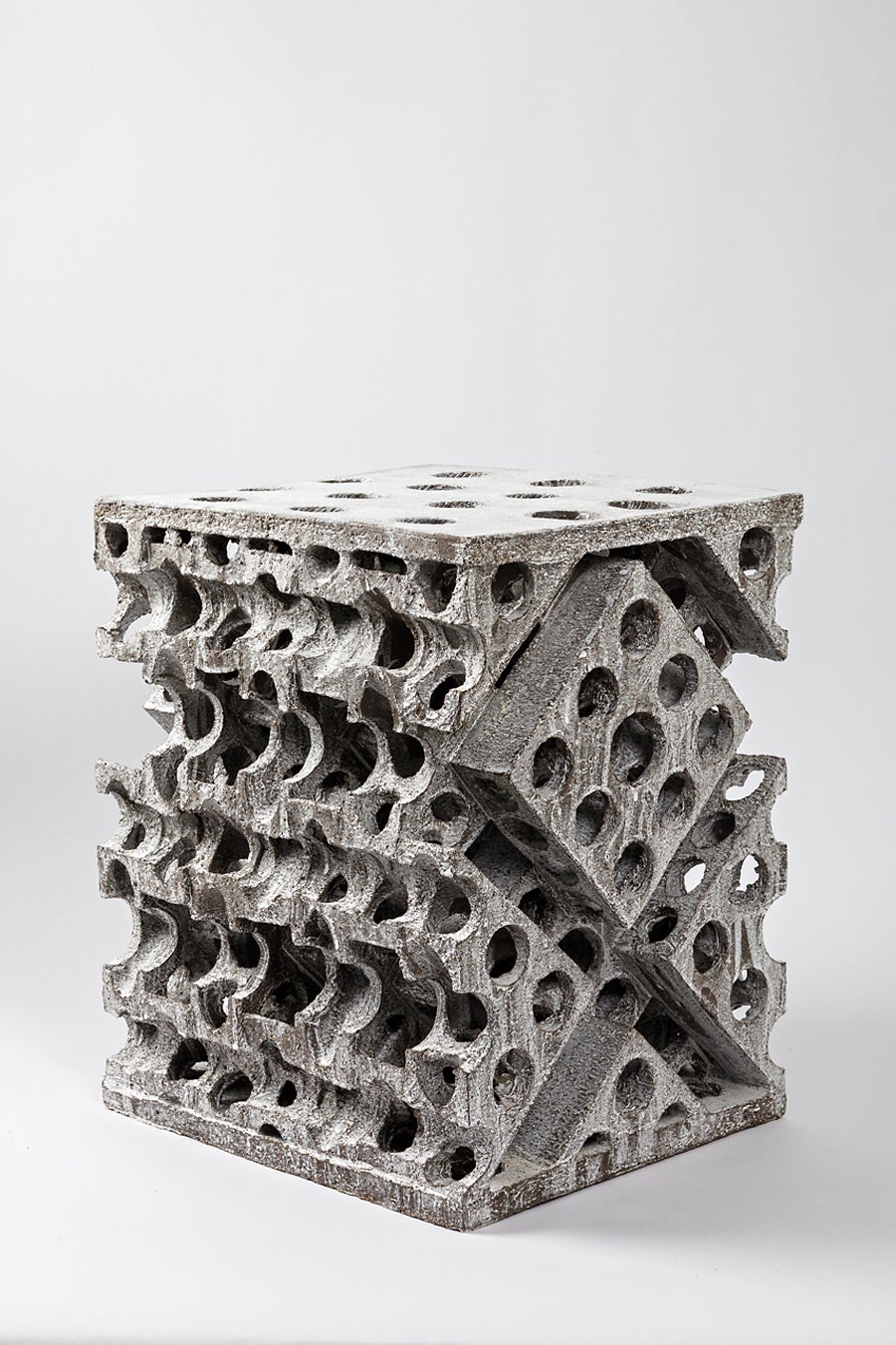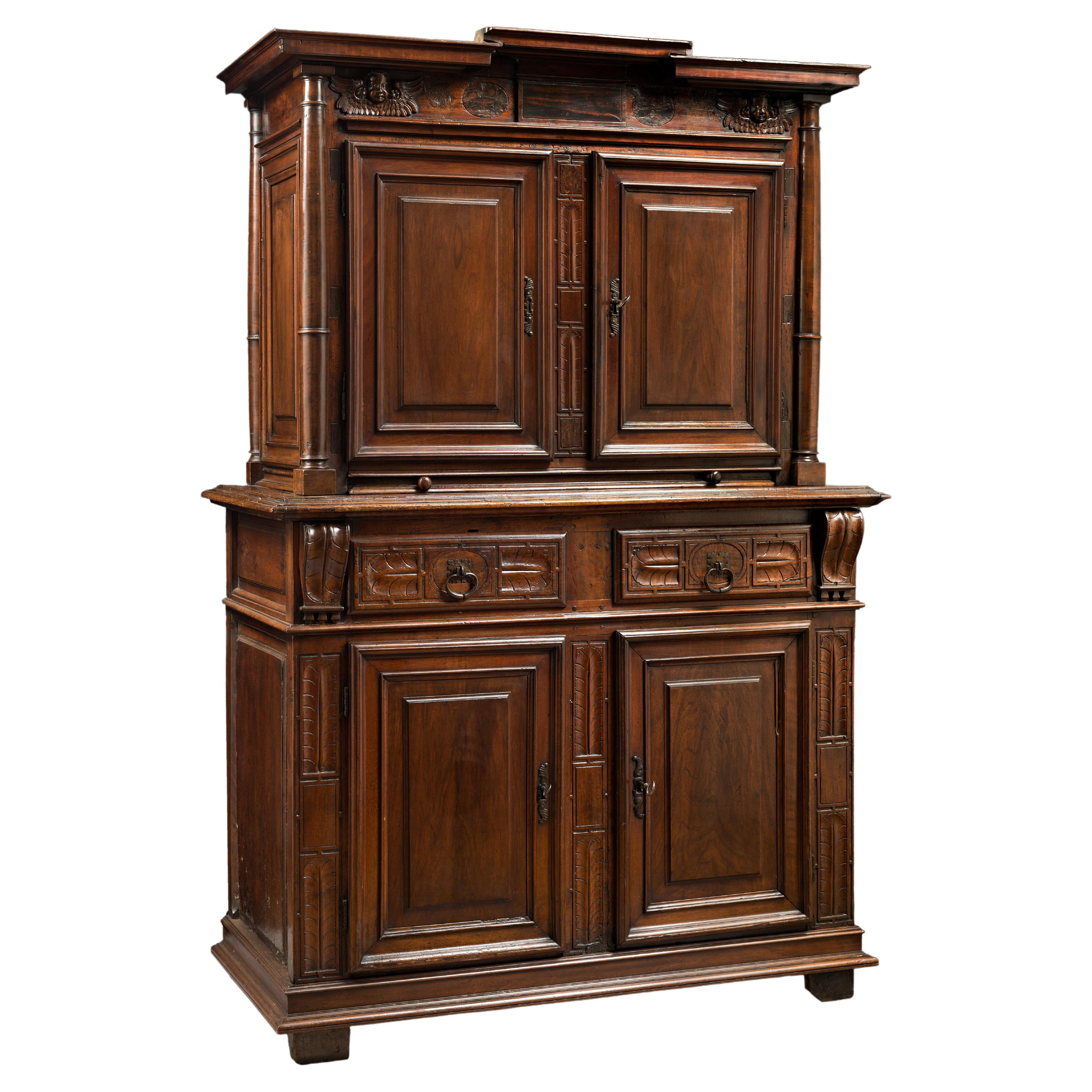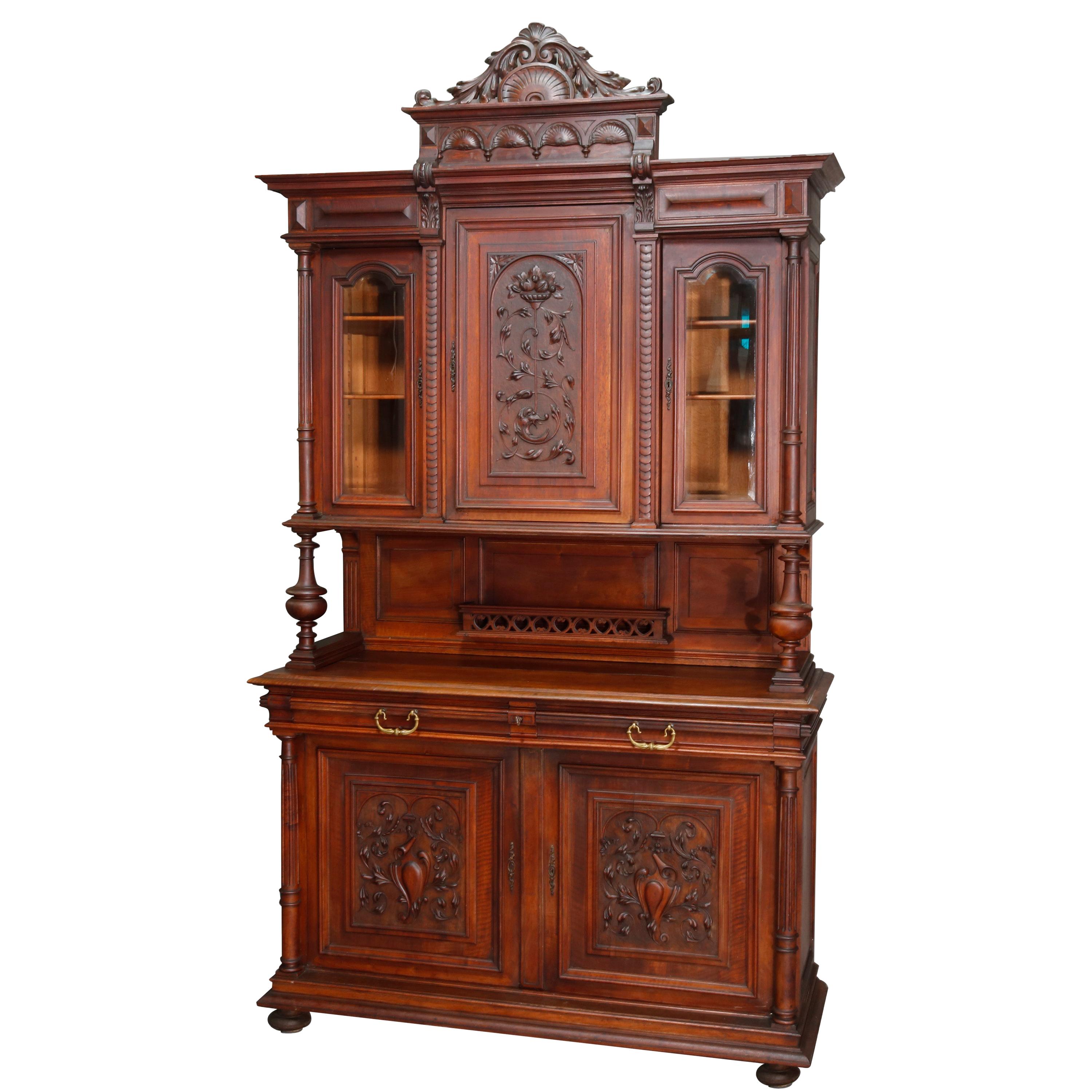Items Similar to 16th Century French Carved Renaissance Cabinet
Want more images or videos?
Request additional images or videos from the seller
1 of 5
16th Century French Carved Renaissance Cabinet
About the Item
Rare carved Renaissance cabinet
Period : 2nd half 16th century, ca. 1570
Origin : France, Burgundy or Languedoc
This cabinet embody the production of the French second Renaissance with its balanced construction, its sober and elgant lines. The diverse ornaments adorning this cabinet produce a real feeling of richness and movement.
Lower Body
The lower body stands on a moulded base enriched with waterleaves carvings and opens with two door-leaves. This panels are framed by decorative friezes and centred with the head of a lion inside a cut-out leathers and low-relief vegetal scrolls. The body frame is enriched with laurel leaves and with a foliated stem in the centre.
The belt shows three foliated consoles and two palm-leaves ornated drawers.
Upper Body
The upper body show a slight recess and is narrower than the lower body. The moulded door-leaf is framed by friezes and palm leaves.
The panel is adorned with two chimeras back to back with a foliated body topped by a flipped pediment. In the centre is carved a mascaron and an eagle with outstretched wings.
This door-leaf is framed by two terms with foliated sheaths carved in high relief. One depicts a bearded male figure while the other one a female. Both of them are crowned with fruits and flowers. A fruit garland is worn around their hips.
The molded cornice is carved with an egg-and-dart frieze.
The lateral panels of the cabinet are enriched by roses.
The decor of this cabinet is divided into independant registers framed by prominent mouldings. With this partition the drawers are particularly highlighted on the lower body.
Proving the influence of the Italian culture in the ornamental vocabulary of the second half of the 16th century this cabinet uses many antic motifs : palm leaves, acanthus, egg-and-dart, fantastic fauna… This wide spreading of the antic motifs was possible thanks to the engravings in which wood carvers found their inspiration.
The gathering of these elements, the abundance and the quality of the sculptures make this cabinet from the second French Renaissance quite remarkable. The very fine walnut wood used for its making and its delicate patina are noteworthy.
Literature
JACQUES THIRION, Le mobilier du Moyen-Age et de la Renaissance en France, Edition Faton, 1998
J.BOCCADOR, Le Mobilier français à la Renaissance, Édition d’Art Monelle Hayot, 1988.
- Dimensions:Height: 76.78 in (195 cm)Width: 45.67 in (116 cm)Depth: 19.22 in (48.8 cm)
- Style:Renaissance (Of the Period)
- Materials and Techniques:
- Place of Origin:
- Period:
- Date of Manufacture:circa 1570
- Condition:Wear consistent with age and use. Minor losses.
- Seller Location:Saint-Ouen, FR
- Reference Number:1stDibs: LU3115327504432

About the Seller
5.0
Vetted Seller
These experienced sellers undergo a comprehensive evaluation by our team of in-house experts.
Established in 2016
1stDibs seller since 2017
151 sales on 1stDibs
Typical response time: 7 hours
- ShippingRetrieving quote...Ships From: Saint-Ouen, France
- Return PolicyThis item cannot be returned.
More From This SellerView All
- 16th Century Renaissance Two-Bodied CabinetLocated in Saint-Ouen, FRFormer collection Altounian At the beginning of the reign of Henri II (1547-1559) the furniture’s ornamentation evolves. The few medieval motifs that were still used are eventually relinquished. Furniture becomes more sober showcasing moulded panels and perfect architecture. Cabinet-makers use ornaments such as curved fluted or plain columns, feather quills, roses or winged putti heads. High-relief carving becomes more scarce and compositions lighter. To that end cabinet-makers draw inspiration from Fontainebleau motifs filtering them and adapting them to French taste. During this period cabinet-makers turn into a kind of architects. Indeed the architectural balance of furniture is the centre of their concerns. The study of Antic formulas is then a necessity. From this care given to proportions appear refined cabinets with pure lines. This style is characteristic of the reign of Henri II and disappears soon after under the regency of Catherine de Medici (1560-1574) when an abundance of high and low-relief ornaments comes back on furnitures. This two-bodies cabinet...Category
Antique 16th Century French Renaissance Cabinets
MaterialsWalnut
- Burgundian Renaissance Cabinet Depicting the Four EvangelistsLocated in Saint-Ouen, FRThe cabinet’s upper body, slightly recessed is topped by an overlapping entablature and cornice supported both in the front and the rear by four fluted columns. The lower body stands on four squared feet and a moulded base. Each door-leaf’s panel is centred by a low-relief carving presenting one of the four evangelists...Category
Antique 16th Century French Renaissance Cabinets
MaterialsWalnut
- 16th Century French Walnut Cabinet with Marble InlaysLocated in Saint-Ouen, FROn the left post of the lower body, is written the date 1596 in a cartouche This cabinet has two bodies. The upper part, set back, is moulded and carved. At the bottom, the cabine...Category
Antique 16th Century French Renaissance Cabinets
MaterialsWalnut
- Renaissance Cupboard from Loire Valley, 'France'Located in Saint-Ouen, FRThis cabinet is composed of two bodies, the upper one being recessed. The extraordinary proportions are enriched by a mythological and floral carved decor. The Lower body stands o...Category
Antique 16th Century French Renaissance Cabinets
MaterialsWalnut
- 16th Century Cabinet with Knights Carving from Avignon Workshops 'France'Located in Saint-Ouen, FRCollection Jean Thuile Around the mid-sixteenth century French furnishing evolves in its conception and ornamentation. The start of major archi...Category
Antique 16th Century French Renaissance Cabinets
MaterialsWalnut
- 16th Century Two Bodied Genoan "Stipo" Cabinet with a Bambocci DecorLocated in Saint-Ouen, FRThis stipo, little Italian cabinet made of walnut and walnut burl, is a remarkable example of Mannerism applied to decorative arts during the late 16th century. While the Manneris...Category
Antique 16th Century Italian Renaissance Cabinets
MaterialsWalnut
You May Also Like
- French late 16th century Renaissance Walnut Deux-Corps cabinetLocated in Troy, NYBeautiful French Renaissance cabinet in two parts. The top part with two carved doors featuring classical figures opening to an interior fit...Category
Antique 16th Century French Renaissance Cabinets
MaterialsWalnut
- French Renaissance Henry II Late 16th Century Walnut Deux-Corps CabinetLocated in Troy, NYFrench Henry II Deux-Corps cabinet, in two parts. Of linear design and interesting, unusual proportions, the top part with two-doors over two drawers, bottom with two larger drawers ...Category
Antique 16th Century French Renaissance Cabinets
MaterialsWalnut
- French 16th and 19th Century Gothic Freestanding Oak CabinetLocated in Troy, NYUnique and rare cabinet with an open base, finished all around, so it could be freestanding in the room, the front panels intricately carved with gothic tracery work, the side and ba...Category
Antique 16th Century French Gothic Cabinets
MaterialsOak
- Monumental Hunt Cabinet 19th century carved oak Black Forest French RenaissanceBy Alexander RouxLocated in Ijzendijke, NLRare monumental Hunt style Renaissance Revival cabinet by Alexander Roux 1870 museum quality piece. Carved out of solid oak with numerous rich details...Category
Antique 1860s American Renaissance Cabinets
MaterialsGlass, Oak
- Antique French Renaissance Carved Walnut Court Cupboard, 19th CenturyLocated in Big Flats, NYAntique oversized French Renaissance carved walnut cupboard with exaggerated crest having acanthus and shell, surmounting triple door ...Category
Antique 19th Century French Renaissance Cupboards
MaterialsWalnut
- Renaissance CabinetLocated in Washington, DCA truly stunning cabinet with a rich patina. Made by a Swedish cabinetmaker in the early 19th century. The paint on the inside and the outside is all original. Original hardware includes the hinges, locks, key, straps. Intricate carved paneling.Category
Antique Early 19th Century Swedish Renaissance Cupboards
MaterialsIron
Recently Viewed
View AllMore Ways To Browse
Antique Renaissance
Cabinet Flower
Renaissance French Renaissance
Renaissance France
French Garlands
Recessed Cabinet
French Carved Flowers
Carved Flowers French
Recessed Storage Cabinets
Antique Show Cases
Antique Show Case
Half Cabinet
French One Door Cabinet
High Renaissance
Italian Carved Cabinet
Narrow French
Antique French Renaissance Furniture
Used Upper Kitchen Cabinets





